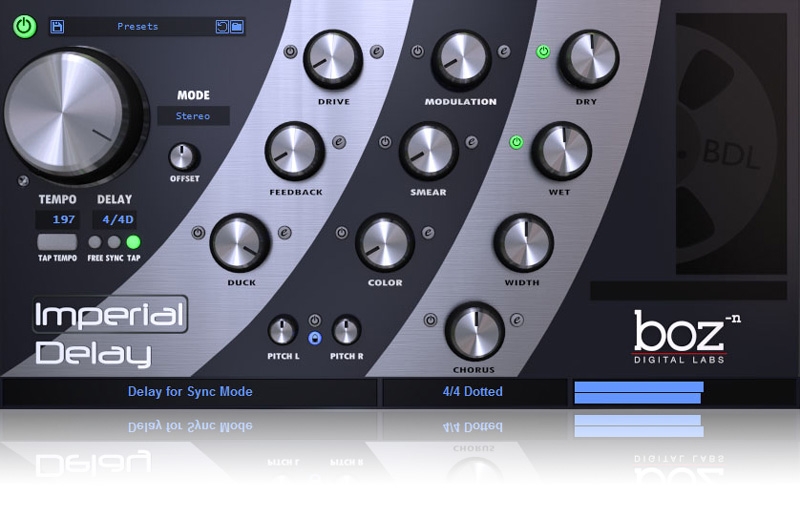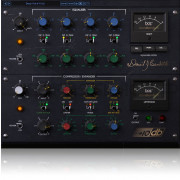You're currently on:
Boz Digital Labs Imperial Delay
The Imperial Delay comprises a highly versatile dual-layer delay with multi-effects, providing maximum sonic possibilities with a minimum of knob twiddling. Distortion, ducking, smearing (for reverb-like delays), offset stereo widening, feedback color, and dynamic feedback are just a few of the features that set it apart from other delays.
While the GUI of Imperial Delay is simple and straightforward, it offers far more creative options than its streamlined front panel suggests. Since Imperial Delay can function as both a delay and multi-effects processor, it’s designed to draw minimal CPU power, which enables multiple instances—something that will come in very handy if you want to dedicate its various capabilities to specific applications such as a lead vocal delay, stereo widening effects, modulation and color, and detune and chorus effects. You can also use it as a distortion generator, or throw caution to the wind and create effects previously unheard by human ears.
Unique Features
Drive, Feedback, Duck, Color, Smear, Modulation, and Chorus controls with on/off buttons and Advanced Section editing controls with presets
“Drive” adds distortion and harmonics to the input signal
“Duck” compresses the delayed output letting you have more extreme delay settings allowing your original dry track shine through
“Smear” softens the sharp edges of the delayed signal enabling it to function like reverb, putting it more in the background
“Offset” delays the right channel; setting becomes a fixed rate relative to the main delay value
“Color” tone-shaping control adds more color to the feedback signal as it repeats
“Dynamic Feedback” changes feedback value via threshold (like a gate)
Advanced section presets let you save individual modifications without changing other settings
Just the Facts
Dual layer architecture with main and advanced controls
Independent wet and dry level controls
Sync mode offers three options: Free, Sync, and Tap
Delay range of 0.1ms to 10s in Free mode
Six delay modes
On/Off for left / right mono channels and center (stereo)
Feedback with polarity controls to add width or ringing effect
Presets can be organized into submenus and shared across platforms and Mac/PC operating systems without changing functionality
Main view
The Delay knob is where the royal edicts of Imperial Delay are carried out. Delay modes include Sync, which tracks your DAW project tempo displaying note values (including triplets); Free lets you dial in a delay value from 0.1 to 10s; and Tap lets you tap in a value in the absence of a DAW tempo setting. There is also independent L-C-R channel activation with a mode display. If you click on the mode display, it offers six options, including standard stereo mode; left/right swap; two mono modes; and two ping pong modes.
Offset
Rather than split the interface into two sections with duplicate controls when you select stereo or ping pong modes, Imperial Delay has a simple Offset control that, as its name implies, lets you offset the left and right channel delays (right channel only). Once set, the offset maintains at the same ratio regardless of the main delay setting. For example, with the delay knob set at 344ms with a 10ms offset (354ms right), if you change the main delay setting to 244ms, the right channel will be 254ms, maintaining the 10ms offset.
Effects
Controls for sound design and effects include:
Drive, which adds distortion and harmonics to the input signal, along with a 20dB overdrive boost.
Feedback sets how the delay is fed back into itself, along with a secondary feedback value that activates when signal drops below its threshold setting
Modulation, which is a short-modulated delay within the feedback loop
Smear, which softens the delayed signal, rounding off the sharp edges of echo to act more like reverb,which can be very useful for instruments with pronounced attacks
Color, which is a tone-shaping control that adds more color with each feedback pass. It also has a slant filter that enables drastic tonal changes without significant volume changes
Chorus is a stereo chorus effect that occurs within the feedback loop, that can create higher timing variation between voices
Duck is a compressor that prevents delays from overwhelming the dry input signal
Width is a straightforward control for stereo widening
Dry and Wet knobs provide independent control of input signal and effect levels
Go Deep
While the main control display is easily discernable to those who prefer to forge ahead without reading manuals, there are some hidden gems in the advanced settings windows, which appear at the selection of button labeled “e.” Advanced settings are available for Drive, Feedback, Modulation, Smear, Color, Chorus, and Duck. When the edit button is selected, the relevant controls appear along with a presets button that gives you an idea of the possibilities the advanced section can give you, along with the ability to save your custom presets in submenus. There are also some hidden gems in the advanced modes, such as the ability to select a chorus effect with 2, 4, 8, or 16 voices. (So break with tradition and read the manual.)
Pitch shift
The Pitch function of Imperial Delay also gives you the ability to independently detune left and right channels. It can create interesting effects, as well as doubling. In subtle amounts, it enhances stereo width without phase issues. In fact, when used with the Chorus effect, you can duplicate the Stereoizer* effect found on the tc electronic System 6000 mastering reverb (saving you around $13,000).





















